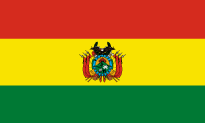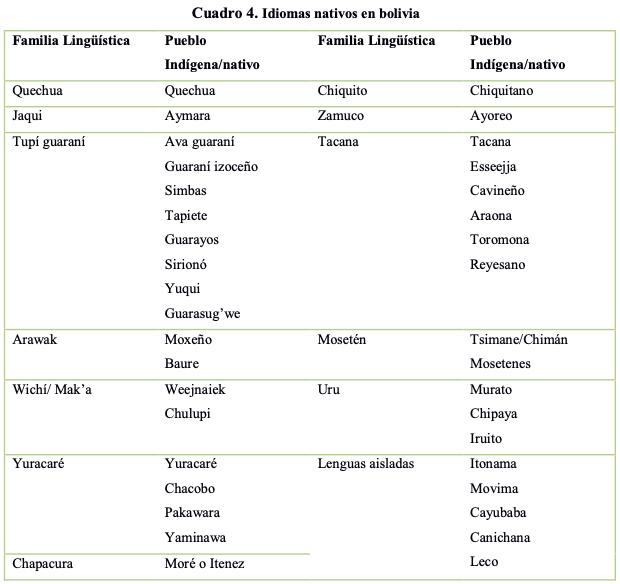
PIACI Diagnosis - Bolivia
Elaboration of the original document:
ALFREDO GARCIA ALTAMIRANO
National Facilitator Peru ACTO/IDB Program
2013 – 2014
INDIGENOUS PEOPLES IN ISOLATION OR INITIAL CONTACT IN BOLIVIA
The national population is made up of three main groups: the indigenous and original, the mestizos and the whites (direct descendants of the colonizers).
The indigenous and original constitute 43% of the population; Those who self-identify as mestizos make up 32% of the country’s inhabitants and are made up of descendants of the union of Spaniards and indigenous/original people. The miscegenation process began with the arrival of the Spanish who introduced slaves from Africa into the region. The result of the unions between these groups gives rise to mulattoes and mestizos.
In colonial times, around 30,000 slaves arrived from Africa, who were forced to work in the mines of Potosí and, later, in La Paz and in the Yungas. Due to its climatic conditions, the slaves who managed to flee and, later, those who obtained their freedom settled in the Yungas region and today make up the Afro-descendant population, representing 3% of the national population.
Despite the great diversity and heterogeneity of indigenous peoples in voluntary isolation and/or initial contact, some general characteristics common to all of them can be identified:
- They are highly integrated peoples in the ecosystems in which they live and of which they are a part, maintaining a close relationship of interdependence with the environment in which they develop their lives and their culture. They have a deep knowledge of their environment, which allows them to live self-sufficiently generation after generation, which is why maintaining their territories is vital for all of them.
- They are peoples who do not know how the majority society works, and who therefore find themselves in a situation of defenselessness and extreme vulnerability before the various actors who try to get closer to them, or who try to accompany their relationship process with the rest. of society, as in the case of peoples in initial contact.
- They are highly vulnerable peoples, who in most cases are in serious danger of extinction. Their extreme vulnerability is aggravated by the threats and attacks suffered by their territories that directly endanger the maintenance of their cultures and their ways of life, since generally, contact processes are accompanied by drastic impacts on their territories that alter their relations with their environment are irremediably modified and often radically modify the ways of life and cultural practices of these peoples. Vulnerability is further aggravated by the human rights violations that are habitually suffered by actors who seek to exploit the natural resources present in their territories and by the impunity that generally surrounds the attacks suffered by these peoples and their ecosystems.”

MAPA INTERATIVO
Observe no mapa interativo do Módulo Povos Indígenas, onde se localizam os territórios indígenas na região amazônica e observe as regiões fronteiriças estudadas pelos consultores da OTCA:
VULNERABILITIES AND THREATS
Apesar de que la actuación de la población indígena de tierras bajas ha sido constante en busca de conciliar criterios, elevar propuestas, inclusive propuestas de leyes, no se le reconoce esa línea profundamente democrática de acción; se prefiere simplemente descalificarlos con insultos o apelativos que nada tienen que ver con la realidad (realidades) de este país.
Los pueblos indígenas de tierras bajas, desde los 90 vienen alertando de los problemas climáticos que inevitablemente surgirían ante los desmontes indiscriminados, la desaparición de flora y fauna y la constante alteración de la naturaleza realizada por manos inescrupulosas. Pero como eran indígenas los que alertaban, nada se hizo. Hoy con el calentamiento global, los desastres naturales provocados por la insensibilidad humana ante la naturaleza, la desaparición de especies animales/vegetales y las alertas detonadas por estudios científicos, algunos están flexibilizando sus posiciones ante la necesidad de preservar y respetar el medio ambiente. Estamos pasando del discurso semántico a en verdad querer tomar acciones.
SYSTEMS OF HEALTH
By the year 2020, the Unified Health System must have universal access, respect native cultures, and be enriched with traditional medicine; inclusive, equitable, supportive, quality and decentralized; conducted and led by the Ministry of Health, exercising full sanitary sovereignty.
Within the elements of the vision, the following order of priorities was established:
- The unique health system with universal access, is respectful of the original cultures and enriched with traditional medicine; it is inclusive, equitable, supportive, of quality and decentralized; conducted and led by the Ministry of Health and Sports.
It acts on the determinants of health.
Actions with the network approach as a way to articulate and interrelate the different health establishments (regardless of their level) with communities (urban and/or rural). - Strengthening the organization of the establishment and its problem-solving capacity.
Development of prevention and care actions for illness and disability in accordance with the protocols and care guides according to the level to which it corresponds. - Respect for the person’s decision regarding the type of care they wish to have, taking into account the culture of the person, family, and community (urban and/or rural).
- Respect for the decision of the family or guardian regarding the type of care without violating the fundamental rights recognized in the CPE.
- Establishment of joint strategies with local authorities for referral and counter-referral to the different levels of care.
- Carrying out care actions within the framework of the protocols and regulations issued by the Ministry of Health and Sports.
- Articulated functioning of the reference and counter-reference system between both medicines.
